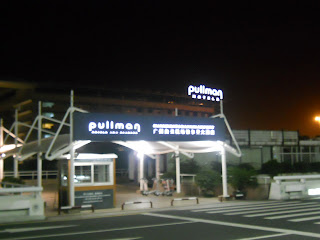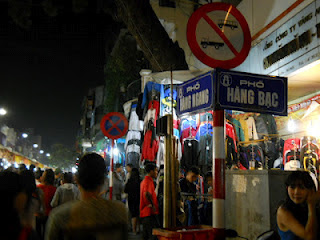 Arriving at Baiyun International Airport in Guangzhou,China thirty minutes pass midnight can be a big problem in terms of transportation and place to sleep.
Arriving at Baiyun International Airport in Guangzhou,China thirty minutes pass midnight can be a big problem in terms of transportation and place to sleep.I was joined by a Muslim couple from Malaysia who were also first timer here. A large section of the arrival halls have lights switched off as we we were on the last plane to land and airport security personnels discouraged us from hanging around here.
A few unlicensed minivans were around soliciting their services but we have no plans of heading into the city in the wee hours.
My main decision was to locate the Departure Hall and spend a night there.
Inside the arrival hall,turn to your right a short distance away is the escalator which will lead you to the skybridge linking to the main Departure Hall.
The escalators worked on sensors whereby if one were about to step on it,then only will it move.
No trolleys were allowed onto the escalators so the other alternative is using the lift elevator and head to the second floor.

The Pullman Guangzhou Baiyun International Airport(pinyin:Jichang) Hotel(pinyin:Jiudian) is a five star business class hotel with room rates from 900Yuan till 1760Yuan and is less than 10 minutes walk from Departure Hall.
At the Departure Hall,seating area were limited so we have to be contented seating on the floor at one corner near the handphone charging points outlets.
If you go to the first floor where restaurants were located ,ample seats were available including kiosks for charging handphone.
There is also a dispenser for hot and cold drinking water beside the washroom at the Departure Hall near Counter H.

Adina Chan,a Muslim with her husband not in photo and Chinese National Miss Lin Win from Fuzhou Province.
We all spent a sleepless night at the Guangzhou's Baiyun International Airport exchanging views and fostering our friendship.
Adina Chan is also involved in internet marketing while Miss Lin Win who will be catching an early morning flight home has just completed her Master in Biology from the University of Florida.
Her next ambition is to pursue for the Phd Degree and is looking forward to complete it in the United States.

Guangzhou is the capital city of Guangdong Province or alternative English name Kwangtung province.
This is the place of origin where Cantonese speaking overseas Chinese communities has its roots.
Guangdong Province main economic hub is Shenzhen and together with Guangzhou are the most populous cities in China having a total 120 million permanent residents and migrants put together.
Guangdong has a humid subtropical climate inland though nearing a tropical climate in the far south. Winters are short, mild, and relatively dry, while summers are long, hot, and very wet.
The city of Guangzhou is further divided into six districts and most travellers will stay round
1) Liwan,
2)YueXiu,
3)TianHe,
4)Haizhu,
5)Huang Pu and 6)north of Panyu.
The original Yuexiu District with a history of over 2000 years is the birthplace of Guangzhou.
Since the ancient times, it has had a strong commercial atmosphere and we still remember it was called Canton at that time.
The Old Canton Backpackers Guesthouse is located around here and do not just hop in to get accomodation.Room occupancy is very high throughout the year.
Another best place to find accomodations is around Liwan area where there are many three star hotels with room rates around 140 Yuan.
The original Liwan features a lot of ancient buildings and the prosperous Shangxiajiu shopping area. Liwan District is located in the west of downtown Guangzhou, on the east and north bank of the Pearl River.
The new Liwan is aimed at building a modern trade and cultural tourism area after adding Fangcun, which enjoys a reputation of "the first flower county in Lingnan."

Guangzhou was historically called Canton derived from a Portuguese transliteration of "Guangdong" which refers only the provincial capital.
If you are a leisure traveller,do not come to Guangzhou during the Canton Fair which is the largest biannual China trade fairs held in Guangzhou.
Hotel rooms will be inflated due to overwhelming demand exceeding supply.
•Phase 1: 15th-19th Oct. 2012 9:30-18:00
•Phase 2: 23rd-27th Oct. 2012 9:30-18:00
•Phase 3: 31st Oct- 4th Nov. 2012 9:30-18:00
Canton Fair Complex, the largest modernized exhibition center in Asia, is located at No. 380, Yuejiang Zhong Road in Pazhou Island, Guangzhou, China.
Canton Fair Buyers enjoy free shuttle bus or hotel bus or you may take Metro Line 8 and get off at the Xingangdong Station or the Pazhou Station.

In 2011, Guangzhou Baiyun International Airport was China's 2nd busiest and world's 19th busiest airport in terms of passenger traffic, with 45,040,340 people handled.
The underground subway Metro train lines were very fast and efficient mass rapid transit line.
Airport South is the the final stop from the city's line 3 which operates from 06:10 till 23:00.
The fares is 7 Yuan to TiYu Xilu interchange.(you need not have to pay further fares during station interchange as long as you did not exit the station.
No washroom within station itself.

With a total length of 18.48 kilometers, the Guangzhou Subway Line 1 is made up of 16 stations, including Guangzhou East Railway Station – Tianhe Sports Center – Tiyu Xi Lu – Yangji – Dongshankou – Martyr's Cemetery – Peasant Movement Institute – Gongyuanqian – Ximenkou – Chen Clan Academy – Changshou Lu – Huangsha – Fangcun – Huadiwan – Kengkou – Xilang
At the following stations of Line 1, you can transfer to other subway lines: Gongyuanqian → Line 2 Yangji → Line 5 Tiyu Xi Lu / Guangzhou East Railway Station → Line 3 (to Airport S) Xilang Station → GuangFo Line(32.16 kilometers from east at Lijiao of Guangzhou to west at Kuiqi Road in Foshan.

In the event travellers do not have small notes or 1 Yuan coins,near the entry to the Metro terminal is a booth where one can exchange the big notes.
The officer here is also very helpful in providing guidance and they do speak a little English as well.

The enquiry and Metro line schedule screen to assist travellers.
At the Departure Hall,go to the lower basement where the Metro line 3 is located. During morning rush hours,the train can be overly crowded and you might miss getting out at specific station as other passengers might block the exit door.
The door only opens for one minute. Don't worry just continue the journey and get off at other stations and just take the reverse train.
There's a LED display of the route station stops near the door so the best way is to count the number of stops that you need to get out.
There'll be an English/Mandarin announcement at each station stops. As long as you do not checkout(putting the plastic coin into the exit slot) of the terminal,you can just sit inside the train whole day but mind you there's no sceneries to see.

Single-trip ticket(a plactic coin token) is often used by tourists.
It is only valid on the day when you purchase it. You can return a single-trip ticket within 30 minutes after you buy it.
Tips how to purchase a single-trip ticket:
a).Find the TVM (Ticket Vendor Machine) according to the signs in the subway station; b).Choose the station on the machine's screen; c).Make sure how many tickets you want to buy;
d).Pay for the ticket according to the amount of the money shown on the screen;
e).Get the ticket and the change. Remark:
The machine only accepts CNY5, CNY10 and the coins of CNY0.5 (5 Jiao coin) and CNY1 (1 Yuan coin).











































